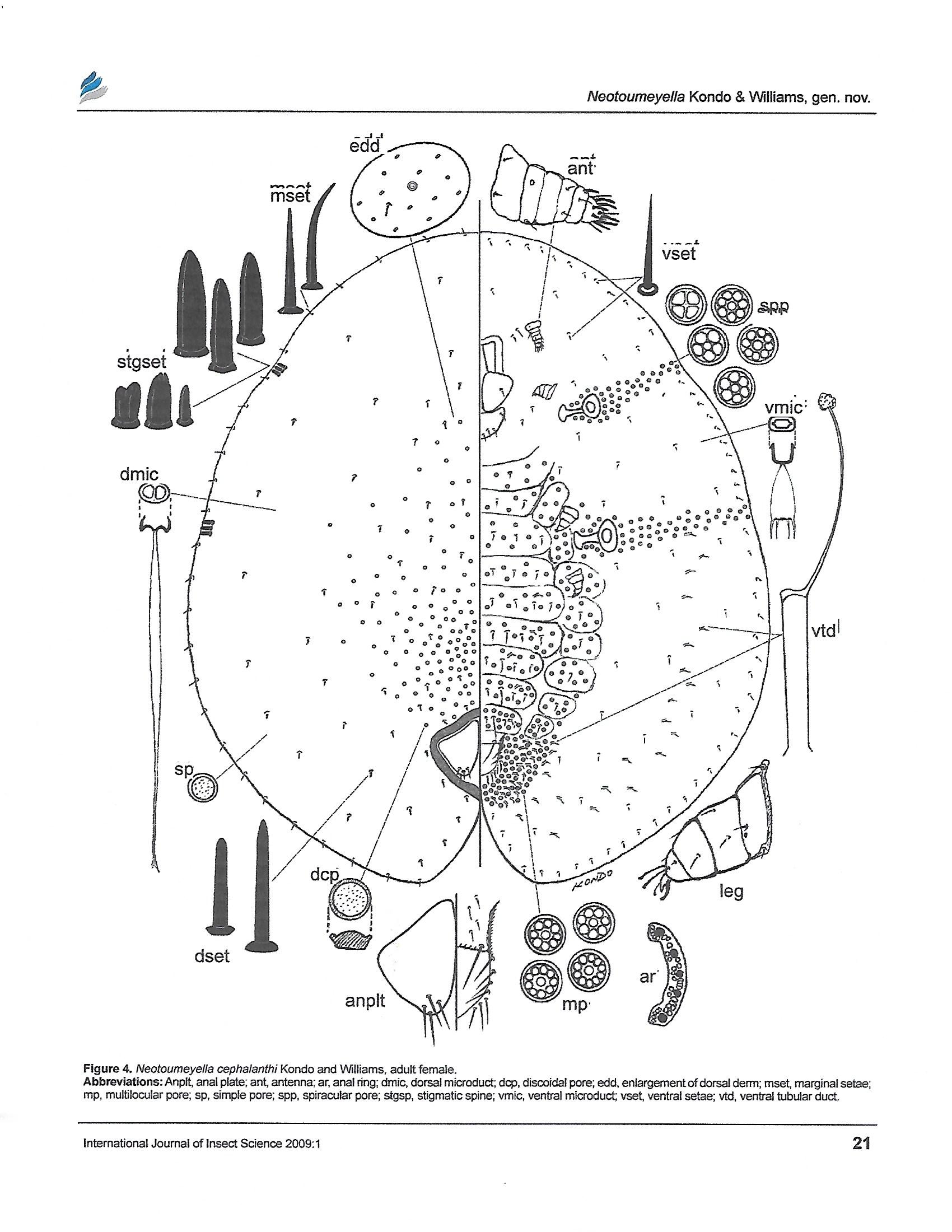Valid Names Results
Neotoumeyella cephalanthi Kondo & Williams, 2009 (Coccidae: Neotoumeyella)Nomenclatural History
- Toumeyella cerifera; Williams & Kosztarab 1972: 160. misidentification (discovered by KondoWi2009, 22).
- Toumeyella cerifera; Hamon & Williams 1984: 117. misidentification (discovered by KondoWi2009, 22).
- Neotoumeyella cephalanthi Kondo & Williams 2009: 20. Type data: U.S.A.: Virginia, Wakefield, Airport Pond, on Cephalanthus occidentalis; collected 16.viii.1969, by M.L. Williams.. Holotype, female, Type depository: Washington: United States National Entomological Collection, U.S. National Museum of Natural History, District of Columbia, USA; accepted valid name Illustr.
Common Names
Ecological Associates
Hosts:
Families: 2 | Genera: 2
- Rubiaceae
- Cephalanthus occidentalis | KondoWi2009
- Salicaceae
- Salix | KondoWi2009
Associates:
Families: 1 | Genera: 1
- Formicidae
- Crematogaster | KondoWi2009
Geographic Distribution
Countries: 1
- United States
- Alabama | KondoWi2009
- Arkansas | KondoWi2009
- Florida | KondoWi2009
- Louisiana | KondoWi2009
- North Carolina | KondoWi2009
- Virginia | KondoWi2009
Keys
- Kondo2018b: pp.4 ( Adult (F) ) [Neotoumeyella species]
- KondoWi2009: pp.15 ( Adult (F) ) [Species of the genus Neotoumeyella]
Remarks
- Systematics: Toumeyella cerifera Ferris originally collected at Agua Caliente, Mexico, has long been regarded as being widely spread in the southern USA. However, Kondo & Williams (2009) after studying type material of Toumeyella cerifera concluded that the species recorded on Cephalanthus from the southeastern USA represented a different species described by Kondo & Williams (2009) as Neotoumeyella cephalanthi sp. nov. Williams and Kosztarab (1972) described a North American species on Cephalanthus as Toumeyella cerifera and considered the morphological differences to be host-induced, but also noted that the North American species did not produce an ovisac as reported for the specimens from Mexico. Kondo & Williams (2009) noted that the illustration of T. cerifera, given by Williams & Kosztarab (1972) and by Hamon and Williams (1984) apparently incorporates characters of both T. cerifera and N. cephalanthi. Neotoumeyella cerifera and N. cephalanthi sp.nov can be easily separated by differences in the distribution of discoidal pores, abundance and types of ventral tubular ducts, and composition of multilocular pores (i,e, 7-12 in N. cephalanthi versus, 6-9 In N cerifera. Neotoumeyella cerifera is only known from Mexico.
- Biology: Tendede by ants of the genus Crematogaster (Kondo & Williams, 2009).
- General Remarks: Description and illustration of adult female by Kondo & Williams (2009).
Illustrations
Citations
- KondoWi2009: description, distribution, host, illustration, taxonomy, 20-22



